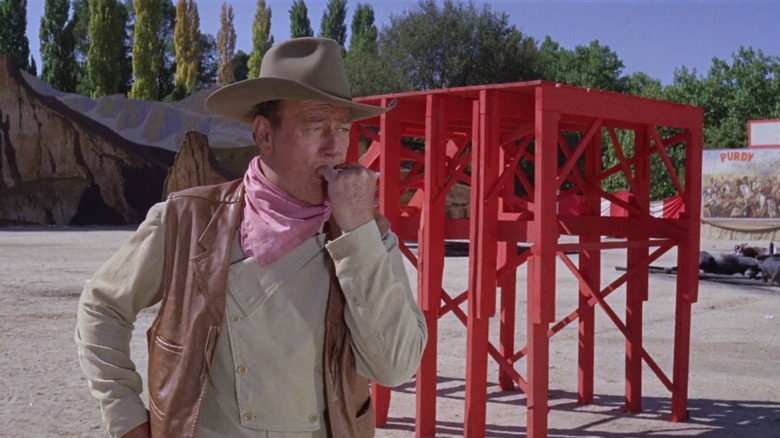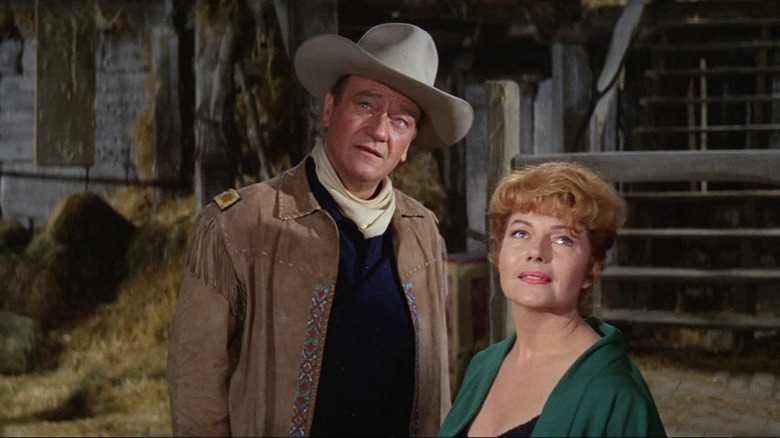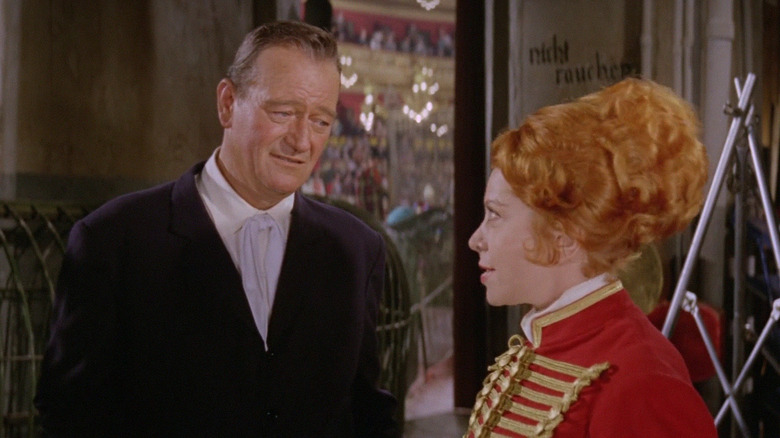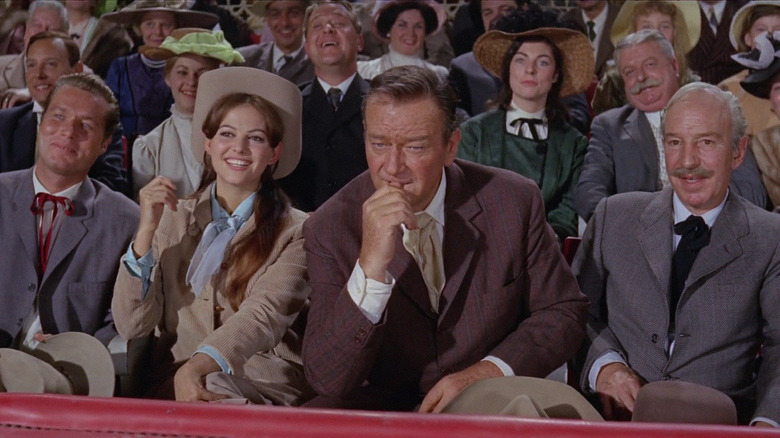An Explosive Circus Stunt Gone Wrong Could Have Been The End Of John Wayne
In the United States in the 1950s, the world opened up. Cars became more commonly owned among American consumers and freeways were built, bringing remote areas closer together. Televisions entered homes, and the post-war economy was booming. Because of increased mobility and competition from movies, the long-held American institution of the traveling circus began to experience a sharp decline in attendance. The idea of seeing a contortionist, a trapeze artist, and a live lion simply lost a lot of their mainstream appeal. As the institution began to fade, Hollywood responded with a wave of nostalgic, halcyon circus films, artistically performing an autopsy on the now-moribund big top. The highest-profile of the 1950s dying-circus genre was "The Greatest Show on Earth," Cecil B. DeMille's ultra-bloated 1952 epic starring Betty Hutton, Charlton Heston, and Jimmy Stewart. It still tops lists of the worst films to have won Best Picture at the Academy Awards.
By 1964, circus films were still occasionally sputtering into theaters, now greeting a world where circuses were a hundredth of their previous size. Is was in '64 that Paramount released "Circus World," a historical drama starring John Wayne. "Circus World" marked the end of a particular "historical epic" era at Paramount in the '60s, as the film had some notable production trouble — Director Nicholas Ray died before production and his replacement, Frank Capra, would split over creative differences. Ultimately, Henry Hathaway would step in.
"Circus World" was not only something of a bomb, but a fire scene put John Wayne in danger, as detailed in Michael Munn's 2005 book "John Wayne: The Man Behind the Myth."
Circus World
In "Circus World," Wayne plays a character directly inspired by Buffalo Bill Cody, the real-life Western cowboy and folk hero who spent many years of his life (in the 1870s through the '90s) performing a in a touring show called "Buffalo Bill's Wild West." The Wayne character in "Circus World," set in 1885, buys a flagging circus with the hopes of reviving it and cashing in on Cody's success. Much of the film is devoted to Wayne building up a new troupe of interesting performers in order to take them on tour throughout Europe.
According to Munn's book, making "Circus World" was a nightmare. Firstly, Wayne was considered past his prime, and one of the film's screenwriters, James Edward Grant was even quoted as saying that all Wayne needed to be in a picture these days was a scene or two with "a hoity-toity dame with big t*** that the Duke can throw over his knee ..." The book also tells a story of how difficult a time Wayne had with his co-star Rita Hayworth. Evidently, Hayworth and Wayne had no chemistry on set, and the actress was reported to be drunk on set often, usually not having learned her lines. Wayne got on much better with Claudia Cardinale, who played Wayne's adopted daughter.
Worst of all was the notorious fire sequence, which cinematographer Jack Hildyard related in Munn's book. Hildyard cleared the air about what happened in the film's fire scene: During a scene wherein the film's big top burns down, Wayne's character was meant to get awfully close to the flames, and he perhaps got a little too close. Hildyard dispels the rumors, however, that Wayne was in any serious peril.
The fire
Hildyard, speaking to Munn, laid it out pretty plainly, addressing whatever rumors he seems to have heard about a dangerous set or The Duke's potential injuries:
"There's a story that goes something like this. For the scene where the big top catches fire, Duke insisted on doing his own stunts. That's true. He worked close to the flames. That's true. The fire got a little out of control. Also true. The blaze became dangerous. Yes, true. Duke carried on working, fighting the fire and turned around to everyone — the director, the cameraman, the crew — had all gone and left him to nearly die in the flames and smoke. Not true."
Even if Wayne was on the waning edge of his career, he was still one of the biggest movie stars in the world, likely insured like crazy, and unlikely to be put into real danger on the set of a circus movie. There's no reason not to believe Hildyard's story. The story did take something of a worrying turn, however, when Hildyard points out that Wayne likely suffered from smoke inhalation, a condition that certainly didn't help the star's lung cancer (Wayne had one of his lungs removed in 1964):
"What happened was, when it got bad, Hathaway told everyone to clear out. Nobody left Duke behind. But he was in danger, and emerged from the smoke coughing badly and his eyes all red. It made for a great scene, but that's not how films should be made. Duke had a bad cough and smoked all the time, and the smoke in the fire scene just made it worse. He was always coughing after that. We'd have to wait before we could shoot sometimes until his coughing had subsided."
By the time "Circus World" was in the can, Wayne was coughing up blood.
Wayne's testimonial
Wayne's own comments on "Circus World" were scant. Wayne appeared in numerous feature films from 1926 until his retirement in 1976, and surely didn't have significant stories from each one of them. In Munn's book, however, a single throw-away comment captured his view on "Circus World":
"I did Pappy's last film which went nowhere and I was all wrong for it; I played a Roman soldier, and I was all wrong for it; and I did the worst circus film ever made, and thinking back, I have to concede that my life was like a f***ing circus. But I'll tell you something. I wouldn't have had it any other way."
"Pappy," incidentally, was the nickname of famed director John Ford, and Ford's last film was the 1970 documentary "Chesty: A Tribute to a Legend," about famed military General Lewis B. Fuller, which Wayne narrated. The Roman soldier reference was to George Stevens' 1965 film "The Greatest Story Ever Told," a star-studded film about the life of Jesus Christ (Max Von Sydow). And that brief description — the worst circus picture ever made — was all Wayne had to say about "Circus World."
Wayne died of stomach cancer in 1979, perhaps exacerbated by his work on a literally radioactive movie set. His own outsize personality remains a well-remembered part of the Hollywood firmament. "Circus World," perhaps not so curiously, is not available to stream or rent online.



